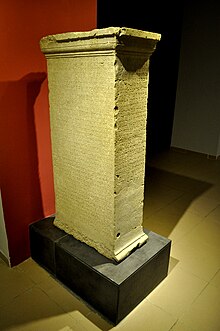
Back Estela trilingüe del Letòon Catalan Trilingue vom Letoon German Trilingva steleo de Letoon Esperanto Estela trilingüe de Letoon Spanish لتون سهزبانه Persian Stele trilingue di Letoon Italian Kherei Anıtı Turkish


The Letoon trilingual, or Xanthos trilingual, is an inscription in three languages: standard Lycian or Lycian A, Greek, and Aramaic covering the faces of a four-sided stone stele called the Letoon Trilingual Stele, discovered in 1973 during the archeological exploration of the Letoon temple complex (devoted to the goddess Leto), near Xanthos, ancient Lycia, in present-day Turkey. It was created when Lycia was under the sway of the Persian Achaemenid Empire.[1] The inscription is a public record of a decree authorizing the establishment of a cult, with references to the deities, and provisions for officers in the new cult. The Lycian requires 41 lines; the Greek, 35 and the Aramaic, 27. They are not word-for-word translations, but each contains some information not present in the others. The Aramaic is somewhat condensed.[2]
Although the use of the term "Letoon" with regard to the inscription and the stele is unequivocal, there is no standard name for either. Xanthos trilingual is sometimes used, which is to be distinguished from the Xanthos bilingual, meaning the Xanthos stele. However, sometimes Xanthos stele is used of the Letoon trilingual stele as well as for the tomb at Xanthos. Moreover, the term Xanthos trilingual (Lycian A, Lycian B, Greek) is sometimes used of the tomb at Xanthos. In the latter two cases only the context can provide clues as to which stele is meant. The Aramaic inscription is known as KAI 319.
- ^ Reger, Gary (2014). "Hybrid Ethnicity and Borderlands in the Greco-Roman World". In McInerny, Jeremy (ed.). A Companion to Ethnicity in the Ancient Mediterranean. John Wiley & Sons, Inc. p. 117. ISBN 978-1444337341.
And the Lycians quite early came to use Greek as well as Lycian for their inscriptions, most famously in the so-called Trilingual Inscription of the Letoon, set up in Aramaic (the ruling language of the Persian Empire, at that time sovereign over Lycia), Lycian, and Greek.
- ^ Teixidor, Javier (April 1978). "The Aramaic Text in the Trilingual Stele from Xanthus". Journal of Near Eastern Studies. 37 (2): 181–185. doi:10.1086/372644. JSTOR 545143. S2CID 162374252. First page displayable no charge.
© MMXXIII Rich X Search. We shall prevail. All rights reserved. Rich X Search